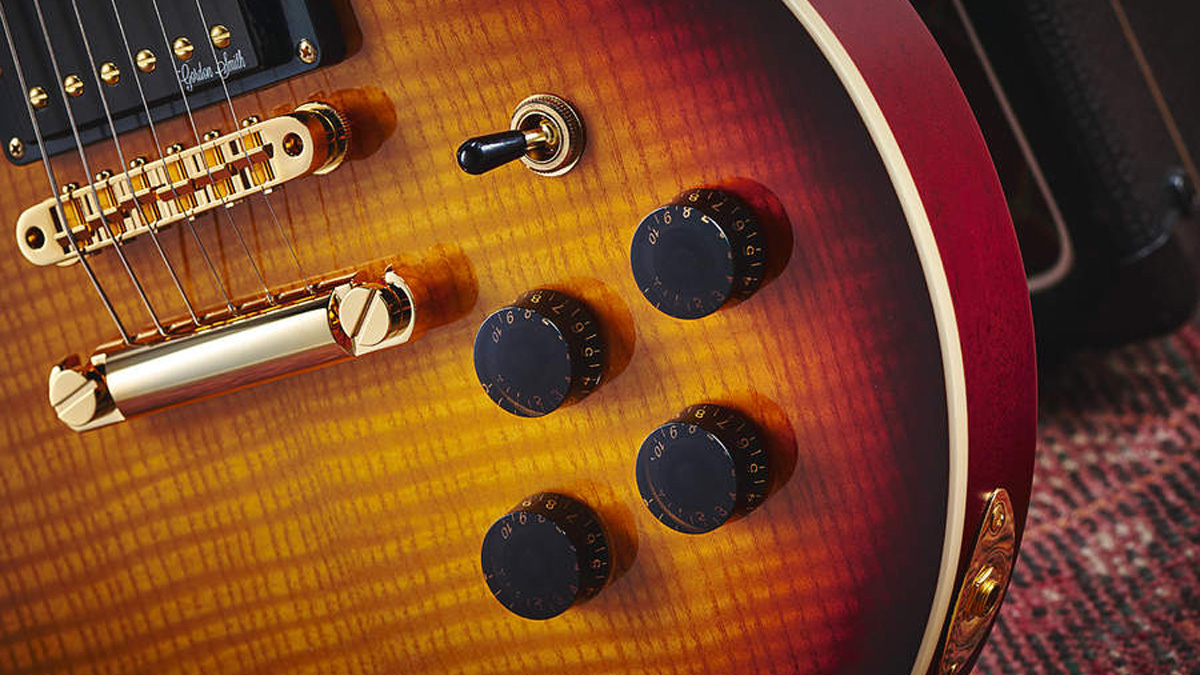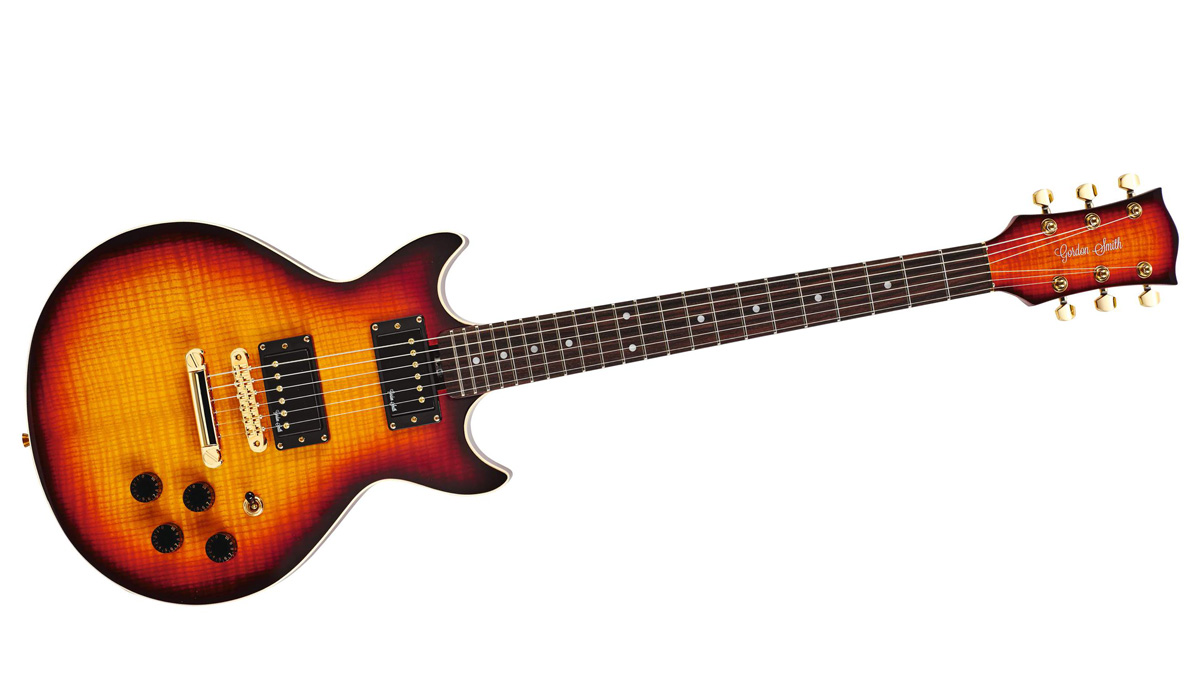MusicRadar Verdict
The GS2 packs a little glitz, while its dual humbuckers/four-control complement expands it into a real do-it-all electric.
Pros
- +
Smart build with slightly posh vibe, lively resonance and very versatile sounds from the dual humbuckers.
Cons
- -
Very little to complain about here although colour options are limited.
MusicRadar's got your back
You could easily dismiss Gordon Smith as a lesser, UK-made Gibson.
They share plenty in style and the GS1 - a sort of ‘Les Paul Jr meets Melody Maker’ - looks like it could have rolled off that Kalamazoo production line sometime during the 1960s. Back in the day, before new owners Auden took over the brand and when there was still a hyphen between Gordon and Smith, the numerous idiosyncrasies of GS founder John Smith often rose to the surface. But now, under the new manufacturing team, those seem to have been pared back, giving the impression of a more mainstream build.
Yet whichever view you take, do not underestimate the potential of Gordon Smith, not least here in this built-for-stock Heritage guitar. The sophisticated-looking Deluxe Heritage, with its dual humbuckers, four controls and gold-plated hardware, chimes in at just £1,119. This is not quite a Korean-made price, but great value for a British build of this quality. Indeed, value for money is a key reason why you might want to test the modern Gordon Smith recipe.
Build and Design
Built around the ‘correct’ Gibson scale of 625.5mm (which John Smith had measured and always used), this model features a double-cut Les Paul outline and is made in the thicker of two styles offered by GSG - the thin body version being just 36mm in depth. Here, the Deluxe Heritage’s mahogany body measures 45.21mm with its additional sycamore veneer top.
Some might be surprised to see a veneer top rather than a thicker slab of maple. “It’s because it’s a fairly simple flat-top guitar,” offers Gordon Smith’s Doug Sparkes.
“It’s not a carved top so it’s really just to put a bit of figure into the guitar. We could cap it with solid figured maple but that would add to the price. One of the commitments I’ve given to GSG fans is we’ll try to keep the guitars affordable. For a UK-built, handmade guitar we’re trying to make sure there’s a lot of choice around £1,000.”
There is no comfort contours to the body. The GS2 features cream binding and a Classic-size neck. Again, like the bodies, one-piece stock (quarter sawn) appears to be used. There aren’t even any headstock widening wings and the GS2 neck is mahogany.

Our test guitar sports a rosewood fingerboard with a 305mm radius and simple dot inlays with the medium jumbo wire, which measures 2.57mm wide with a height of approximately 1.24mm. There’s a visible wheel-type adjustment for the truss rod at the end of the neck - a new feature for the Auden era - along with a more conventional two-way truss rod.
Another new addition is the ‘tone pocket’. “I can’t tell you about that,” laughs Doug. “It’s something our team here has worked on and we believe it results in more contact between the neck and body at the point of the joint. It’s quite small if you look at it from a length point of view, but once you get inside the guitar, there is a flange that widens out to give more contact between the body and the neck beyond what you can see.”
Electrics
This model uses a modern version of John Smith’s humbucking design. It uses style black plastic casings - with all the internal gubbins encapsulated into the cover. Magnet swaps or the like? Forget it. But, while we’re on the subject, John Smith always used ceramic (Barium ferrite) magnets that are still part of the current design.
“Yes, these original Heritage-spec Gordon Smith humbuckers are wound exactly the same way, on the same machine that John used. But we also have a more modern winder purely because John’s original machine would never cope with the number of pickups we need today. So, along with that, we’ve been playing around with different winding patterns and balances across the two bobbins so that when you, for example, coil-split one of the pickups on the GS1000 you get less of a volume drop that traditionally you can get with coil splits.”
The controls also retain a twist or two from John Smith - the coil-split function is on the volume control (which voices the slug coil) not the more usual tone control, and each pickup circuit uses a pair of 0.022 microfarad tone capacitors and a pair of 0.002 microfarad ‘treble bleed’ caps that have been slightly tweaked compared to the pre-Auden wiring (certainly according to an original GSG wiring diagram we have).
Back then, as now, Gordon Smith does things slightly differently, but not without reason. “Our tone circuit is designed to give you a more usable tone roll-off. We want to try to make that humbucker as functional as it can be. A lot of players like the single pickup guitars, so we want that pickup to do as much as possible. We know we’ve got people out there in metal, rock, blues and country bands and they’re all doing it with those humbuckers.”
Spec and Sound
Weight-wise, our model feels business-like but are not overly heavy. There’s an impressive acoustic ring and resonance. However, with the heel-placed upper-strap button, this guitar does tend to tip forward a little, in a similar way to a Gibson SG.
The Deluxe’s thin neck measures in back to front at 20.4mm at the first fret. Moving up to the 12th fret, we measured a depth of 23.5mm. Meanwhile, width at the nut measures at 43.1mm.
The bridge pups on the Deluxe come in at 8.12 kohms on the Deluxe. That is quite a low reading compared to classic ceramic ’buckers such as DiMarzio’s Super Distortion (13.68k) and Seymour Duncan’s JB (16.6k).
As ever, DCRs don’t tell the full story and here there’s plenty to compare and contrast. But the thing that’s evident with these GSG humbucking guitars is that they very much have their own thing going on. Bright, clean humbucking with a hotter-than-vintage kick gets you some of the way. The bridge pickup also has a fairly relaxed midrange.
If you need the thicker, focused power of a Duncan JB, you don’t get that here, certainly with both volume and tone fully up. The splits - which voice the slug coils - are pretty traditional and can sound a little thin and bright yet, as ever, with neck and bridge combined on the Deluxe there’s plenty of Fender-y texture and bounce. The neck voice is matched both in full humbucking mode or in split mode.
Using a Knaggs Kenai with Duncan Seth Lovers for comparison, plugging in the GS2 Deluxe illustrates that GSG sound. It is notably light and bright in tone: strikingly so for (veneer aside) an all-mahogany guitar. Plug in a PRS Singlecut and, well, the GS2 now sounds rather polite! But stick with it and a very interesting, useable and versatile tonality emerges.
It’s the tone controls that unleash the beast, so to speak. Don’t be afraid to dial them back to tame some of those highs. Neither rolls off to a muddy ‘woof ’ in either humbucking or split mode. With both pickups on and one tone wound fully down you don’t quite get the classic ‘women’ tone but something quite a bit clearer. The tone circuit, common to all three guitars, keeps that crisp edge throughout the volume’s travel, offering an impressive degree of clarity and bringing a decent rhythm/lead capability to the single pickup models.
If we step back from the heritage of the UK’s longest-running production guitar company for a moment and just consider this simply as a new guitar, one quality stands out proudly above all other virtues: excellent value for money.
Factor in the one-piece wood stock, smart build, good components and the unique and highly useable voicing and you have a proposition that’s hard to ignore.
The GS2 packs a little glitz, while its dual humbuckers/four-control complement expands it into a real do-it-all electric.
Dave Burrluck is one of the world’s most experienced guitar journalists, who started writing back in the '80s for International Musician and Recording World, co-founded The Guitar Magazine and has been the Gear Reviews Editor of Guitarist magazine for the past two decades. Along the way, Dave has been the sole author of The PRS Guitar Book and The Player's Guide to Guitar Maintenance as well as contributing to numerous other books on the electric guitar. Dave is an active gigging and recording musician and still finds time to make, repair and mod guitars, not least for Guitarist’s The Mod Squad.
“A synthesizer that is both easy to use and fun to play whilst maintaining a decent degree of programming depth and flexibility”: PWM Mantis review
“I feel like that song had everything we needed to come back with”: Bring Me The Horizon’s Lee Malia on Shadow Moses, its riff and the secrets behind its tone, and why it was the right anthem at the right time
“I said, ‘Are we sure we can write a song about death?’”: The story of Mike + The Mechanics' classic No.1 The Living Years











